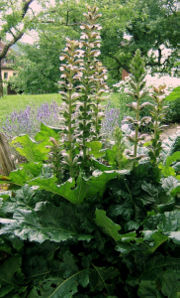Acanthus mollis: Difference between revisions
Jump to navigation
Jump to search
No edit summary |
No edit summary |
||
| Line 1: | Line 1: | ||
{{SPlantbox | |||
| | |familia=Acanthaceae | ||
| | |genus=Acanthus | ||
| | |species=mollis | ||
| | |common_name=Bear's Breeches | ||
| | |habit=herbaceous | ||
| | |Max ht box=39 | ||
| | |Max ht metric=in | ||
| lifespan = | |Max wd box=39 | ||
| exposure = | |Max wd metric=in | ||
| water = | |lifespan=perennial | ||
| features = | |exposure=sun, part-sun, shade | ||
| | |water=moderate, dry | ||
|features=drought tolerant | |||
|Temp Metric=°F | |||
| sunset_zones = 4-24, 28-32 | |sunset_zones=4-24, 28-32 | ||
|image=2007-06-26Acanthus07.jpg | |||
| image = 2007-06-26Acanthus07.jpg | |image_width=180 | ||
| image_width = | |||
}} | }} | ||
Describe plant here... | |||
{{Inc| | {{Inc| | ||
Acanthus mollis, Linn | Acanthus mollis, Linn. Lvs. 2x1 ft., cordate, sinuately pinnatifid, mostly radical: fls. summer; spikes loose, pubescent. Gn. 52, p. 239.—Also recommended as a window plant. Var. latifolius, Hort. (A. latifolius, Hort. A. lusitanicus, Hort.) is larger and hardier. | ||
}} | }} | ||
| Line 78: | Line 70: | ||
{{stub}} | {{stub}} | ||
__NOTOC__ | |||
Revision as of 18:11, 18 August 2010
| Acanthus mollis subsp. var. | Bear's Breeches | |||||||||||||||||||||||||||||||||||||||||||||||||||||||
|---|---|---|---|---|---|---|---|---|---|---|---|---|---|---|---|---|---|---|---|---|---|---|---|---|---|---|---|---|---|---|---|---|---|---|---|---|---|---|---|---|---|---|---|---|---|---|---|---|---|---|---|---|---|---|---|---|

|
|
| ||||||||||||||||||||||||||||||||||||||||||||||||||||||
| ||||||||||||||||||||||||||||||||||||||||||||||||||||||||
Describe plant here...
| Standard Cyclopedia of Horticulture |
|---|
|
Acanthus mollis, Linn. Lvs. 2x1 ft., cordate, sinuately pinnatifid, mostly radical: fls. summer; spikes loose, pubescent. Gn. 52, p. 239.—Also recommended as a window plant. Var. latifolius, Hort. (A. latifolius, Hort. A. lusitanicus, Hort.) is larger and hardier.
|
Cultivation
| Acanthus mollis calendar? | ||
|---|---|---|
| January: | ||
| February: | sow | |
| March: | divide | |
| April: | transplant | |
| May: | flowering | |
| June: | flowering | |
| July: | ||
| August: | ||
| September: | ||
| October: | divide | |
| November: | ||
| December: | ||
| Notes: | ||
- Do you have cultivation info on this plant? Edit this section!
Propagation
- Do you have propagation info on this plant? Edit this section!
Pests and diseases
Snails and slugs can cause bad damage, especially on young growth.
Cultivars
Gallery
If you have a photo of this plant, please upload it! Plus, there may be other photos available for you to add.
-
photo 1
-
photo 2
-
photo 3
References
External links
- w:Acanthus mollis. Some of the material on this page may be from Wikipedia, under the Creative Commons license.
- Acanthus mollis QR Code (Size 50, 100, 200, 500)
